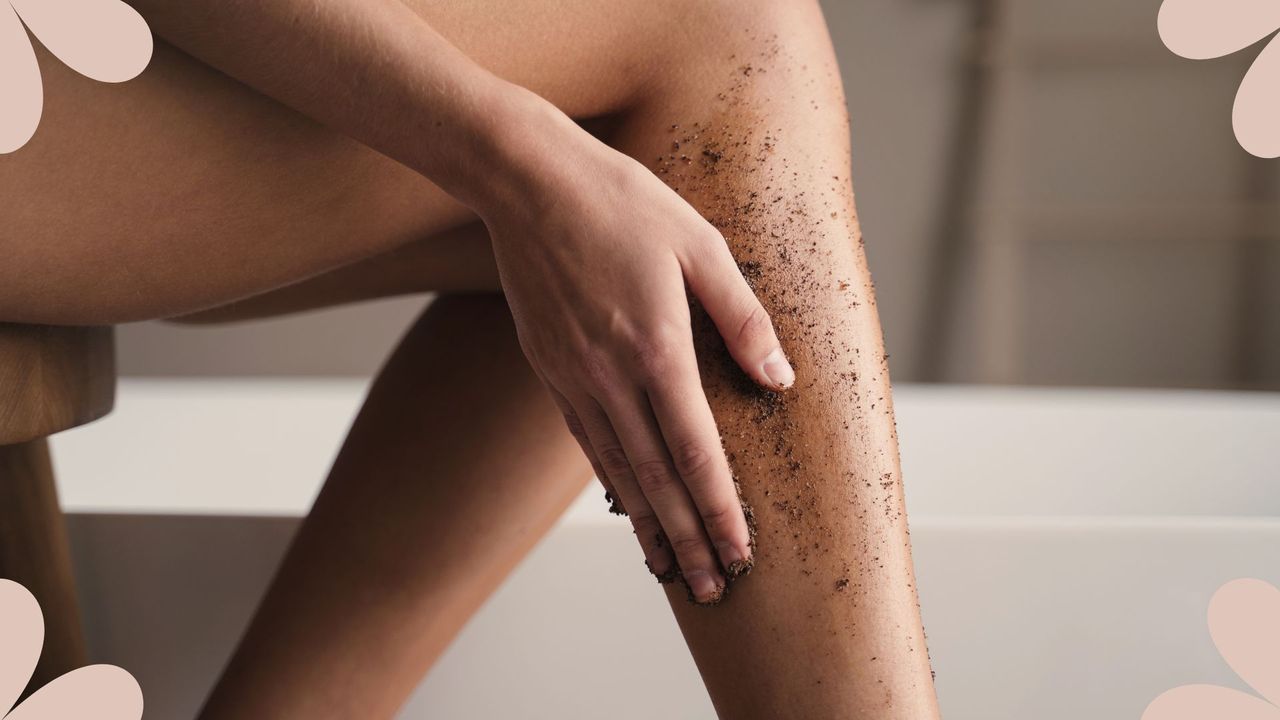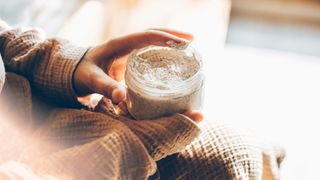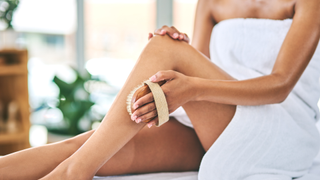How to exfoliate your body for silky-smooth skin
Skin experts share how to exfoliate your body at home, with tips on the best methods


Learning how to exfoliate your body is your golden ticket to smooth, glowing skin that’ll make you feel far better about yourself than a joyless pre-holiday diet.
Exfoliation is the removal of dead cells from the top layers of our skin using one of the best body exfoliators. This process does happen naturally, with new cells replacing old ones like a conveyor belt, but sometimes needs a helping hand to keep things running smoothly. “Exfoliating will improve your skin tone and texture,” explains skin expert Fiona Brackenbury. “The more frequently and consistently you exfoliate, the more the quality of your skin is improved as dead skin cells are banished and new cells are revealed. ”
Alongside a silkier texture and enhanced glow, exfoliation has a number of other benefits. It can reduce dry skin, prevent breakouts and help you to avoid ingrown hairs. The process of massaging an exfoliant into the skin will help with lymphatic drainage, and if you exfoliate before your holiday, it will help your tan last for longer. “It will also help other products you apply to your body to absorb more effectively,” adds Dr. Sophie Shotter, aesthetics doctor at GetHarley. How to exfoliate your body is also different from how to exfoliate your face, as there are varying factors to consider.
How to exfoliate your body
1. Choose the right approach
It’s not a case of one-size-fits-all when it comes to how to exfoliate your body, and you need to consider which approach best suits your skin and your lifestyle. “There are so many types of body exfoliators to choose from, from exfoliating sugars and salts to gentle enzymes and acids,” says Brackenbury. “It’s good to choose the exfoliator that fits best into your routine."
She continues, "If you have no time to physically exfoliate then a body lotion with chemical exfoliants may suit you better. If you love the feeling of exfoliation then try a daily exfoliating shower gel, or treat yourself to the satisfaction of a weekly salt scrub. Getting your exfoliator right will help ensure you use it consistently.” It’s a bit like a perfectly fitting t-shirt versus one that’s a bit tight in places. Don’t force something that’s not a natural fit – you’re always going to wear the more comfortable one more often.
2. Get physical
When you think of how to exfoliate your body, you usually think of a scrub, right? “Physical exfoliation involves the use of scrubs which mechanically help to lift away the dead skin cells from the surface,” says Dr. Shotter. “What’s left beneath is smoother, more vibrant skin.”
They’re really satisfying to use, but have gained a bit of a reputation for being too harsh on the skin. “We need to be careful not to overdo it,” continues Dr. Shotter. “Choose a product that has even-sized beads in it rather than uneven kernels which can cause micro tears and damage to the skin.” Salt scrubs and sugar polishes are also good as they dissolve as you use them, giving an exfoliating effect that’s not too harsh. Or, avoid scrubs altogether and use a muslin cloth, exfoliating mitt, or body brush to manually exfoliate instead.
Sign up for the woman&home newsletter
Sign up to our free daily email for the latest royal and entertainment news, interesting opinion, expert advice on styling and beauty trends, and no-nonsense guides to the health and wellness questions you want answered.
You can physically exfoliate all over your body, but just be gentler on the neck and chest as the skin can be more sensitive here. “Paying extra attention to specific dry areas such as elbows and knees will result in a more even finish as often these rough areas can appear lighter,” adds Brackenbury.
3. Try chemical
Unlike physical exfoliation, there’s no buffing or polishing of the skin when it comes to how to exfoliate your body with chemical (also known as liquid) exfoliants. “With chemical exfoliation, skincare acids such as glycolic or lactic acid are used to help loosen the bonds that hold dead skin cells in place, helping to slough them away,” explains Dr. Shotter. There are three types of chemical exfoliants – alpha-hydroxy acids (AHAs), which are the strongest and great for improving glow, beta-hydroxy acids (BHAs), which are best suited to oily skin to prevent congestion, and poly-hydroxy acid skincare (PHAs), which is the gentlest and best for light exfoliation. Torn between glycolic acid vs salicylic acid? The first is an AHA and the second a BHA. Choose based on whether you want to prioritise brightness or keeping blemishes at bay.
Chemical exfoliants are pretty low maintenance and mess-free to use as they come in lotions and moisturisers that can be simply smoothed onto the skin and left to work their magic, so they’re pretty low maintenance. You won’t see immediate results, but if you apply before bed you’ll notice that your skin looks brighter by morning. Even better, they’re often formulated with nourishing ingredients to help rehydrate the skin after the exfoliation process.
4. Give enzyme a go
Alongside chemical and physical exfoliation, there’s a third way of how to exfoliate your body that doesn’t get quite as much air time, and that’s enzyme exfoliation. “Enzyme exfoliation works to loosen the bonds between skin cells and is often more gentle than acid-based chemical exfoliation,” says Dr Shotter. “This makes it more suitable for regular use, use by sensitive skin types, and use during very hot weather.”
Have you ever experienced a strange tingly feeling in your mouth after eating pineapple? That’s the perfect example of enzyme exfoliation and is caused by an enzyme called bromelain breaking down the proteins in your mouth. It works the same way on your body, except the result is super smooth skin rather than a tingling tongue.

5. Take care with sensitive skin
Sensitive skin is a bit of a catch-all term that covers skin that’s easily irritated and prone to redness, as well as conditions like eczema, psoriasis, and rosacea. “Those with sensitive skin on the body need to be careful with exfoliation,” warns Dr. Shotter. “In particular those prone to eczema for whom exfoliation can be very sensitizing.”
If you’d consider your skin to be on the sensitive side, it’s best to go slow with exfoliation. If you’re using a scrub, apply it to wet skin so that there’s a bit more slip, and only do so once a week. Poly-hydroxy acids (PHAs) are the weakest of the chemical exfoliant family so our top choice for touchy skin. It’s the same with sensitive skin on your face - being gentle is key.
6. Change with the seasons
Our skin can behave differently and has shifting needs depending on the season. For example, humid conditions in summer can mean increased hydration in the skin, while whipping winds and central heating in winter can dehydrate our complexions. When it comes to how to exfoliate your body and how often, Dr. Shotter believes we need to go through the motions more during the winter than the summer. “Even though we have more skin on show, our bodies will usually need less exfoliation than over winter,” she explains. “This is because over winter our skin cell turnover slows down and often we get a build-up of dry skin. For average skin, I’d recommend exfoliating twice weekly over summer and four times weekly in winter.”
On the other side of the coin, Brackenbury thinks you should prioritize exfoliation during the summer months more than in winter. “We should exfoliate all year round but there is something to be said for extra exfoliation in the summer. Just as the skin holds on to the dead skin cells as we age, the same process happens when the sun is present. The skin sees the sun as a threat to the skin and feels it’s being attacked, so it will hold onto the dead skin cells in order to protect itself. But, the skin won’t feel this way if the body has sun protection on.” See if you notice your skin feeling rougher during certain times of the year and up or reduce your exfoliation accordingly.
7. Increase as you age
“As we age, skin cell turnover slows down meaning we shed dead skin cells less efficiently so need to exfoliate more frequently,” advises Dr. Shotter. If we don’t increase exfoliation, this backlog of cells will start to show on your skin, “giving it a dull, ashy appearance, as well as making it appear dry and sometimes scaly,” adds Dr. Shotter.
But, before you go gung ho with daily exfoliation, remember that there are other changes happening in the skin during this time. “As we get older the skin is starting to feel more vulnerable,” explains Brackenbury. “It becomes thinner and drier, with less collagen and structure. The skin sees holding onto dead skin cells as a great way to protect itself and provide extra defenses.” Try exfoliating just a couple of times a week and building up only if your skin is happy to avoid impairing its natural barrier and causing irritation.
8. Consider body brushing
Want to level up your body care? Consider learning how to exfoliate your body with a dry brush part of your routine. “Body brushing is a great way to exfoliate as it will focus on the dead skin cells that are loose and ready to leave the skin,” says Brackenbury. “The skin will look smoother and softer, and you’re also helping to boost circulation, aid lymphatic drainage and reduce fluid retention.”
The best way to body brush is to work in short, almost flicking motions from your hands and feet up your legs and arms towards your torso. Then, repeat the journey using longer, more sweeping strokes. On your stomach and back you can body brush using circular motions. How often should you dry brush? You can do it every day if your skin is happy.
Ideally, you want to be combining body brushing with other forms of exfoliation. “What you’re missing out on if you’re only doing body brushing is the nourishing skin ingredients found in exfoliators,” Brackenbury continues. “Plus, you’re only going to remove the loose dead skin cells as it won’t go as deep as exfoliating acids. My expert recommendation is to do a combination of both body brushing and chemical exfoliation.”

9. Rehydrate afterward
The process of exfoliating can be quite drying. Think of it a bit like a workout for your skin – and if you’d just done a spin class, you’d definitely want a big glug of water at the end to rehydrate. “I would certainly recommend using a good body moisturiser after exfoliating to help rehydrate the skin,” says Dr. Shotter.
Moisturising with one of the best body creams will also help you to hold onto that newly acquired softness. “These brand new cells need nurturing with lots of omegas and moisture to ensure the skin barrier is enforced and has long-lasting softness,” says Brackenbury.
10. Follow with SPF
The pros of exfoliation are bringing all of those lovely shiny new skin cells to the surface, but the con is that these fresh cells are more prone to sun damage. “You should always apply sunscreen afterward,” says Dr. Shotter. “Exfoliation removes the outer layer of skin, meaning you will absorb more UV radiation and be more prone to sunburn and sun damage. You will also potentially find that chemical exfoliants increase this risk even further.”
Make sure you’re slathering on a daily broad-spectrum sunscreen with at least SPF30 protection, and reapplying regularly if you’re spending time outdoors. If you’re sensitive, you may want one of the best sunscreens for sensitive skin and if you experience blemishes you’ll want one of the best sunscreens for acne-prone skin. Remember, UV rays, which are responsible for the majority of skin aging, are present all year round and can penetrate through glass and clouds.
Should you exfoliate your body in the shower?
Not sure whether exfoliation should come before, during, or at the end of your shower? Even the experts are divided, so we don’t blame you for being a bit confused. According to Brackenbury, you should, “always exfoliate before taking a shower unless you’re using body lotions with built-in exfoliation, and in this case, you can apply those directly after the shower to clean dry skin. Exfoliating before showering also means that you can effectively clean the skin once the dead cells that are blocking your pores have been banished. If you’re using a messy scrub, you may want to do this in the shower so you’re not having to clean the bathroom floor after exfoliating.”
On the flip side, Dr. Shotter recommends you to “exfoliate afterward, even if you’re using a scrub. This means your skin is clean and prepared, but also the heat from the shower or bath will help to soften the skin and make it more receptive to exfoliation.” There are pros and cons to both sides, so really it comes down to which fits best with your routine.
Should you exfoliate your body dry or wet?
Ideally, you should exfoliate skin when it’s dry. All chemical exfoliating lotions and moisturisers are best applied to dry skin as otherwise they’ll just slide right off – or you’ll end up diluting the formula. Physical exfoliation with either a mitt, a scrub, or a body brush is best on dry skin as you’ll create a bit more traction this way. If you add water, there’s more slip.
As always, there are exceptions though. “The best way to exfoliate is on dry skin,” says Brackenbury. “You may find if you have touch-sensitive skin (where it becomes red and flushed when massaged) or sensitised skin then exfoliating onto damp skin will lessen the friction and give a softer, gentler experience.” Some scrubs will also recommend they’re only used on damp skin, so check the usage instructions if you’re not sure.
Jess Beech is an experienced fashion and beauty editor, with more than eight years experience in the publishing industry. She has written for woman&home, GoodtoKnow, Now, Woman, Woman’s Weekly, Woman’s Own and Chat, and is a former Deputy Fashion & Beauty Editor at Future PLC. A beauty obsessive, Jess has tried everything from cryotherapy to chemical peels (minus the Samantha in Sex and The City-worthy redness) and interviewed experts including Jo Malone and Trinny Woodall.
-
 Sienna Miller's best hair and makeup moments from across the years
Sienna Miller's best hair and makeup moments from across the yearsWe revisit some of her top beauty looks from the archives...
By Lucy Abbersteen Published
-
 Katie Holmes broke an unspoken fashion rule in tights and mules - her shoes are available for less than £100 on Amazon
Katie Holmes broke an unspoken fashion rule in tights and mules - her shoes are available for less than £100 on AmazonThe statement gold kitten heels are a surprisingly versatile spring staple
By Charlie Elizabeth Culverhouse Published
